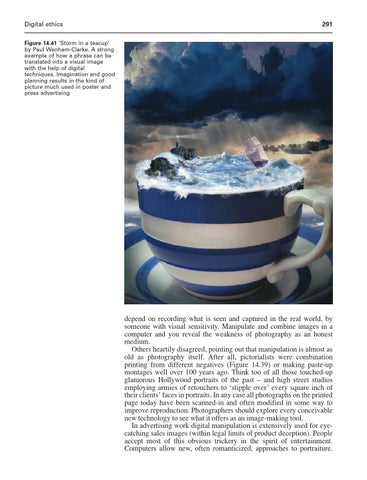Digital ethics
291
Figure 14.41 ‘Storm in a teacup’ by Paul Wenham-Clarke. A strong example of how a phrase can be translated into a visual image with the help of digital techniques. Imagination and good planning results in the kind of picture much used in poster and press advertising
depend on recording what is seen and captured in the real world, by someone with visual sensitivity. Manipulate and combine images in a computer and you reveal the weakness of photography as an honest medium. Others heartily disagreed, pointing out that manipulation is almost as old as photography itself. After all, pictorialists were combination printing from different negatives (Figure 14.39) or making paste-up montages well over 100 years ago. Think too of all those touched-up glamorous Hollywood portraits of the past – and high street studios employing armies of retouchers to ‘stipple over’ every square inch of their clients’ faces in portraits. In any case all photographs on the printed page today have been scanned-in and often modified in some way to improve reproduction. Photographers should explore every conceivable new technology to see what it offers as an image-making tool. In advertising work digital manipulation is extensively used for eyecatching sales images (within legal limits of product deception). People accept most of this obvious trickery in the spirit of entertainment. Computers allow new, often romanticized, approaches to portraiture.
